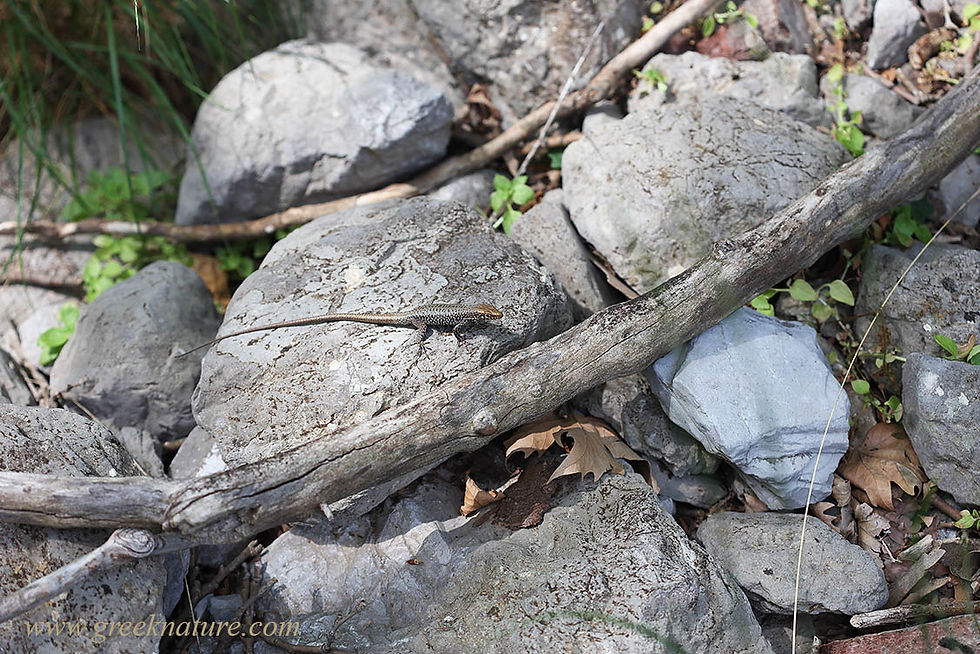More ancient than the mountains
- Philippos Katsiyiannis

- Nov 26, 2021
- 3 min read
Greek Rock Lizards Hellenolacerta graeca, are endemic Lacertids of Peloponnisos, the southernmost peninsula of mainland Greece. They are among those gems for which Peloponnisos is renowned. And even for a resident of this place, like myself, it is always a joy to observe them, let alone find them in places where it was not known that they existed before.
I live near Patras, a city at the north-west part of Peloponnisos, belonging to Achaia prefecture. Some years before, the Greek Rock Lizard was not known from any place in Achaia prefecture. The lizard is common to the south of Peloponnisos, where can be observed by the sea, and also common in places of the central region of the peninsula. But going north, one sees that the places to find this animal are getting scarce.
Anytime I wanted to see one, I had to take a road trip of 2 or more hours to the south. But I was curious if the rugged mountain Erymanthos that I see from my home, was hiding some of them. I had searched for them some times, in various places, but no success. One day in May 2016, after having studied the maps of the area, I went for the southernmost tip of Achaia, south of Erymanthos Mt, to a many-a-lizard promising place. It was almost failure, for after the whole day searching, I was forced to leave the place without seeing a single specimen. And there, just as I was leaving, in the middle of the road was a lizard. And yes, it was Hellenolacerta graeca. My joy was overwhelming. At least, I knew there were Greek Rock Lizards in Achaia too. But again, this was one and a half hour from my home.

I was looking mountain Erymanthos, a 2224 metres tall, very steep mountain, every day from my window. And every day I was wandering if there were any of these lizards north of this very high mountain. Some excursions with friend Elias Tzoras to the north yielded no results. In April 2017, friend Alexis Panagiotopoulos, found one animal at the southern slope of Erymanthos, and then another one more to the south. Alexis has a very intimate relationship with this area, studying it for a scientific project and searching it very intensively. Again, he found only 3-4 places with 1 or two individuals every time, in 3 years. It was clearly a difficult animal with sparse populations there. And the question remained: where any animals to the north of the very high mountain?

It was April 2021 when I proposed to friends Olga Tzortzakaki and Giorgos Iliopoulos to have a day-trek in a place where we would walk in prime habitat for the Greek Rock Lizards. The place was to the north of mountain Erymanthos and only 1/2 hour from my home. When we reached the place and left the car, within 10 minutes we came along a very small lizard, dark, exactly like an Algyroides moreoticus. You can imagine my exhilaration when I saw from within the camera, that it was a Greek Rock Lizard.

The critter did not stay long, it vanished inside a small bush after 5 seconds, never to be seen again. But I was over the top, it was the first time that I had found the species north of Erymanthos, and so near to my home. And of course, if it was here, I would find all its relatives, right? Well, searching all day long, walking all day long, this small immature individual, was the only Hellenolacerta we saw that day.

We left the place with joy, having found the species, but disappointed having not found more animals. Yet, we walked much and found many other species.









After this initial discovery, I was determined to find more animals. I wanted to make some decent photos as well. So, two weeks after the discovery, I started alone, to search again the place. After all, it was very close to my home and it was full Spring. Oh, how innocent I was! After going again to that specific spot, nothing. After searching all the slope, nothing. After searching all day long, after searching everything that would be worth searching, absolutely nothing. I got back home empty-handed. I started to think that I had made a wrong identification in the first place and the small lizard was indeed an Algyroides. Fortunately, there was that one photo. The lizards were somewhere there, and we had to find them.
So we started again, with friend Alexis Panagiotopoulos, to find them. Passing from the first spot, there was nothing there. I thought how lucky we were the first time, we could have seen nothing. Passing from a big plane tree, our luck suddenly changed. There, on a rock, a Greek Rock Lizard was basking and slowly coming our way.


It was a pair living there, sharing the plane tree with Algyroides moreoticus and a sheepish Bufo bufo.













Comments